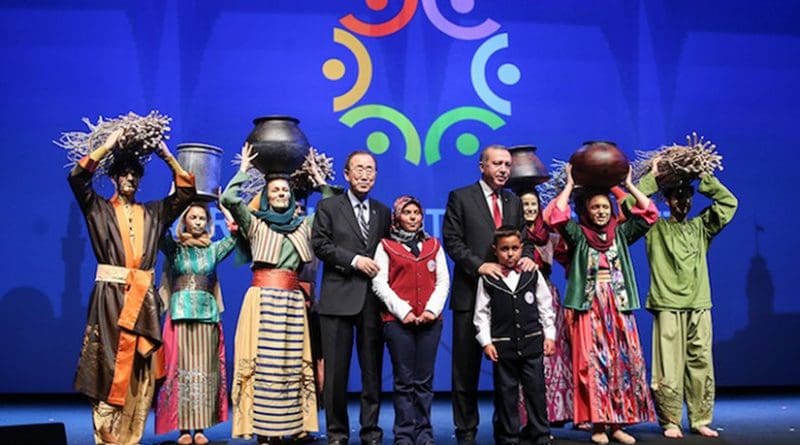World Humanitarian Summit: Meeting Expectations Or Falling Short? – Analysis
By RSIS
The World Humanitarian Summit held in Istanbul, Turkey on 23 and 24 May 2016 saw 9,000 delegates from governments, United Nations agencies and civil society come together to address a ‘broken humanitarian system’. Did it achieve what it set out to do?
By Alistair D. B. Cook*
The World Humanitarian Summit in Istanbul on 23-24 May 2016 achieved two notable goals despite the absence of several world leaders. The first was a ‘Grand Bargain’ to distribute humanitarian funding more equitably by 2020. The second was the formal launch of the Regional Organisations Humanitarian Action Network. However, in a side-event, a significant step forward was achieved for Southeast Asia – the launch of an ASEAN-United Nations humanitarian partnership highlighting the increasingly prominent role of regional organisations.
The absence of several world leaders, aside from the summit ending with only a general commitment to enhance compliance to humanitarian principles, however, raised questions over the progress made on the global humanitarian front.
Grand Bargain and Regional Leadership
The World Humanitarian Summit was initiated four years ago by United Nations Secretary-General Ban Ki-Moon to reaffirm a global commitment to humanity and humanitarian principles; initiate actions and commitments which enable countries and communities to prepare for and respond to crises and be more resilient to shocks; and to share best practices which help save lives around the world, placing affected people at the centre of humanitarian action and alleviating suffering.
One of the recurring challenges facing the global humanitarian system is how to fund it. For too long, the vast majority of money has been spent among a small number of agencies, with less than 2% of available funds going to local NGOs. At the World Humanitarian Summit, leaders agreed to commit to increase the percentage of funds available to local NGOs from 2% to 25% by 2020.
A significant step forward in this is the commitment to greater transparency to further encourage the wider disbursement of donor funds for humanitarian projects through efficiency savings amounting to an estimated US$1 billion over the next five years. This wider distribution of humanitarian funds aims to particularly benefit local communities to take the money closer to those it is supposed to assist.
While the Summit launched the Regional Organisations Humanitarian Action Network with the aim to build the capacity of regional organisations and collaboration between them, a side-event highlighted work was already underway. A joint forum saw the launch of the ASEAN-UN Joint Strategic Plan of Action on Disaster Management that increases the collaboration between the regional and global bodies, particularly in the area of Emergency Response and Assessment Teams.
This partnership also envisions empowering local leaders in humanitarian assistance and disaster management more broadly in Southeast Asia, which is important if the humanitarian financing reforms are to be turned into action by 2020. In the middle term the development of humanitarian leadership will be central to make the region a global humanitarian leader. What is noticeable in this side-event is that it already takes a necessary step to put a key summit outcome into action.
Purpose or Progress?
These outcomes from the World Humanitarian Summit illustrate important steps forward, but will likely be overshadowed by the failure to agree concrete action on already established humanitarian principles. Just ahead of the Summit, a global humanitarian leader in the field, Medecins sans Frontiers (Doctors without Borders), decided to pull out because it saw the Summit as no more than a ‘fig leaf of good intentions that will do little to help the world’s most vulnerable or those trying to help them’.
It was a bold move that underlined a deepening tension in the humanitarian system that revolves around the inaction of states to uphold International Humanitarian Law [IHL], particularly to prevent the targeting of civilians and civilian facilities from hospitals to schools in conflict zones.
While participants at the Summit reiterated the need to uphold IHL, recognised the ‘denial of humanitarian access deprives people of human dignity,’ as well as a proposal to raise awareness of healthcare personnel, and a proposal to adopt a declaration to spare medical facilities from military use, these amounted to little that will satisfy the humanitarian community in providing for and protecting vulnerable communities and those that help them.
Falling Short Except in the Regions
Ultimately the draft outcome document of the World Humanitarian Summit outlines a series of areas that will create positive change if implemented. However, it falls short of what many wanted to achieve, and global summits often do. What the World Humanitarian Summit does offer are some concrete proposals for collaboration in less controversial areas.
It highlighted the importance of a fairer humanitarian financing system and the continued rise of regions as a site for leadership and action, to turn words into deeds. As seen at the World Humanitarian Summit, ASEAN-UN activity on the summit side-lines will ultimately have greater impact on the development of a humanitarian system in this region.
It also once again illustrates that ASEAN is a first-mover in disaster management. The World Humanitarian Summit may have brought 9,000 delegates together but many might have left without the summit making the desired impact.
*Alistair D. B. Cook is Coordinator of the Humanitarian Assistance and Disaster Relief Programme and Research Fellow at the Centre for Non-Traditional Security Studies (NTS Centre), S. Rajaratnam School of International Studies, Nanyang Technological University, Singapore.

